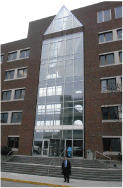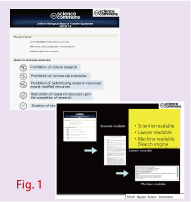|
 |
■Bioresources information is available at the following URLs
|
 |
|
Hot News from Abroad 〈NO.30〉 Science Commons -Promoting Sharing of Research Achievements through the Web-〈 I 〉
Mutsuaki SUZUKI, Director, Intellectual Property Unit, National Institute of Genetics
1. Science Commons
Today, large-scale research projects handle a massive amount of data, and numerous research resources, data, academic articles, and patents are produced as research achievements. "Creative Commons" proposed the openness of research achievements by presenting easy-to-understand license conditions via the Internet in academia and then founded "Science Commons" in 2006 to promote the openness of research achievements in scientific fields.
Science Commons aims to enable research achievements to become reusable, to realize one-click access to research resources, and to integrate scattered information. Science Commons is currently operated by 5 full-time employees at the Massachusetts Institute of Technology (MIT) campus in Boston, USA (Photo 1).
|

|
I had the opportunity to visit with Koichi Sumikura, associate professor, the National Graduate Institute for Policy Studies, in February this year at the Science Commons office. Based on the hearings at the time, I will now introduce the breakdown of the present state, the sharing framework, and the development of tools with regard to research resources, data, academic copyrights, and patents.
Photo 1:
Science Commons office is in a buildings at Massachusetts Institute of Technology (MIT) |
2. Framework of Sharing Research Resources and MTA |
As a result of the enforcement of the Bayh-Dole Act* in the US, universities now possess intellectual property rights and institutionalized material transfer agreements (MTAs), which compelled them to spend a great deal of labor and time for negotiation. To address the issue, NIH and the Association of University Technology Managers (AUTM; see BioResource now Vol.5, No.4) drafted the Uniform Biological Material Transfer Agreement (UBMTA), NIH guidelines, and the Simple Letter Agreement (SLA; simplified MTA), but it remains difficult to resolve the issue.
Science Commons analyzes the current situation as follows:
-
Most biological resource collections have not been organized and catalogued.
- Most universities and individual laboratories are short of human resources for preserving and distributing biological resources.
- The technology licensing organization (TLO) of universities employs institution-specific MTAs and appends special terms.
- Universities and corporations share few research resources. Although a deposition of biological resources to a resource center that does not require MTAs is one of the solutions, the ratio of resources that are actually deposited in these centers is low, and thus, this does not necessarily resolve all the issues.
|
 |
Science Commons (Fig. 1) minimizes the time and cost for obtaining research resources, facilitates easy access of resources to researchers for immediate initiation of research, consolidates online ordering systems for convenient ordering of research resources, and carries the meaning of MTAs to scientists in an easy-to-understand manner.
* The Bayh-Dole Act is part of the United States legislation pertaining to the intellectual property developed by the academic-industrial alliance.
|
In particular, Science Commons designed catchy icons for each condition of MTAs, presented license conditions for each research resource to scientists, and was able to relate with contracts that can also be referenced by layers. In addition, metadata of the research resources were also tagged so that the researchers can easily access information on the resources through a search engine.
In addition, MTAs of the Science Commons are in transition from Ver. 1 to Ver. 2. The MTAs were reduced to the following three types:
1) Open use
2) Research use
3) Specific-disease use
These MTAs have already been employed by the Huntington's Disease Foundation, Personal Genome Project, and Coriell Institute for Medical Research. Science Commons encourages no-MTA transaction of research resources as far as possible and proposes the use of standard MTAs such as UBMTA or Science Commons' MTA among others if MTAs are ever used.
|
3. Data Management - Regarding CC0 - |
Most data simply comprise facts or ideas, and thus, cannot be published as literary works. However, policies regarding the right to protect data differ among countries. For example, the database protection policy in the EU created new rights, and similar database protection rights were developed in Korea.
The following five issues are considered as specific problems in data sharing.
①Preservation of data, the perishables, as the status quo is difficult.
②References and storages of each fact of data are often unclear.
③Tracking license information of data is difficult when integrating the data, and the number of contributors for obtaining the data are often too many, and reference notes are multilayered.
④Often, due to an excessive number of contributors for obtaining data, attributing the license of the data to the contributors is difficult.
⑤In relation to international cooperation, determining whether or not the data holds copyrights is difficult due to the difference in data protection legislations among countries.
|
In order to resolve these issues, Science Commons proposed the CC0 (CC zero) license, which indicates that authors waive all copyrights over the authors' data. This implies that the authors claim no rights over legal attribution and only request that the data be referenced, which is a custom or rule among scientists. In addition, rights regarding morals, patents, and trademarks are not released.
The CC0 license is applied to data and databases and was designed to minimize or eliminate legal uncertainties of databases. Users will take no legal obligation as if using the data in a public domain under the conditions of CC0.
|
All the genome data are currently provided under the CC0 license in the Personal Genome Project. In addition, the CC0 is also employed in a mouse genomics expression database in the Coordination and Sustainability of international Mouse Informatics Resources (CASIMIR), which is one of the mouse consortiums in EU, and a drug side effect database in the European Molecular Biology Laboratory (EMBL).
(Activities of Science Commons regarding scientific works and patents will be introduced in the sequel to this newsletter issue.) |

Figure: CC0 icon (left) and the website of Creative Commons (right) |
|
|
|
Easy Drafting of a Web-based Questionnaire by Google docs
|
An easy method of drafting an online questionnaire by Google docs will be introduced this time. Google docs is a convenient tool to edit documents and spreadsheets online and also has a feature that enables one to draft a web-based questionnaire form. In addition, the newest summary of the questionnaires posted by users can also be viewed. The installation procedure of a questionnaire form will be introduced below. |
1. Login to Google docs
Google docs can be accessed from "more" → "Documents" in the top menu of the Google website. Login by typing tyour email address and password into the box located on the upper right corner. (A user without a Google account can open an account using the "Create an account now" link, free of charge.)
|

|
2. Drafting a Questionnaire
| Select "Form" from the "Create new" menu on the upper left. |

|
3. Customizing a Questionnaire Form
Edit the questionnaire items on the website. As items of the form, boxes for free-typing in text and radio buttons for selecting choices are available, and various formats of questionnaires can be drafted.
|

|
4. Embedding a Completed Questionnaire in the Website of Your Choice
| Select "Embed" in the "More actions" menu on the top.
|

|
| An HTML script for embedding the form will be displayed, and then, copy and paste the script on to your own blogs or websites.
| 
|
5. Example Display of a Questionnaire
| The drafted questionnaires will be displayed on your browser as shown in the right figure. |

|
6. Summary View of a Questionnaire
In addition, a summary of the posted results of a questionnaire can be displayed in the form of pie charts or tables by clicking on "Summary" in the "See responses" menu.
|

|
Questionnaire forms can easily be installed, as introduced above. Please draft a questionnaire using Google docs in order to gather opinions on your own blogs and websites. (Takehiro Yamakawa)
|
|
|